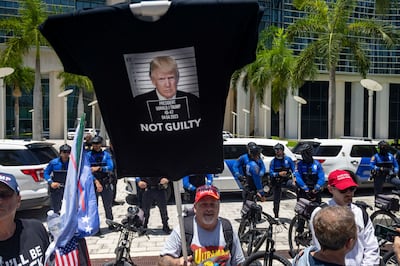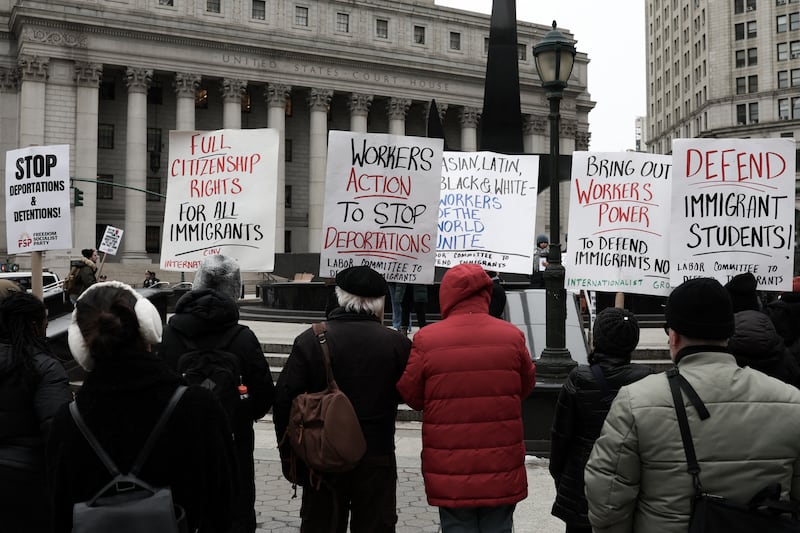A grim Donald Trump leaned back from the defendant’s table inside a jammed 13th-floor courtroom in Miami on Tuesday, jaw set, arms crossed, his back muscles tensing visibly under his dark suit jacket.
About 20 feet away, in the second row of the visitors gallery, was Jack Smith, the special counsel who had put him there, alert and poker-faced. Smith looked on as three Justice Department lawyers under his supervision offered Trump a bond agreement to release him on his own recognisance, without bail, that was respectful and accommodating, but profoundly humbling.
After a 50-minute courtroom encounter unlike any other in US history, Trump exited by a side door recessed in dark wood panelling, but not before allowing himself a curious peek over his shoulder at the 40 or so reporters crammed into the room.
About a minute later, Smith and his team walked to the opposite side of the room and left wordlessly. He did not look back.
First group of migrants deported from US arrive in Costa Rica
US objects to calling out ‘Russian aggression’ in G7 statement on Ukraine
Wisconsin election gives Democrats glimmer of hope as Trump tariff decision looms
Irrational view of science under Trump not reflected beyond US, says EU research funder
The first arraignment of a former US president on federal charges coincided with the first public encounter between Trump and Smith, the two men at the centre of the Mar-a-Lago documents case. They did not say a word to each other. But these most dissimilar of adversaries are locked in a legal battle with immense political and legal implications for a polarised nation.
[ Trump court appearance: ‘I just had to come and show my support’Opens in new window ]
Trump’s body language in the courtroom suggested he understood the gravity of the situation. A former president who thrives on being in control seemed uncomfortable with having so little as a defendant.
Trump, who has denounced his indictment as a witch hunt and called Smith a “thug,” did not say a word at the hearing. Nor did the magistrate judge, Jonathan Goodman, ask him a single question, as sometimes happens in criminal arraignments.
Several of Trump’s political aides were seen outside the courthouse mixing with a small but vocal group of supporters, who were shouting their support over the chopping of a helicopter hovering above.
Inside, the hearing itself was a quiet and strikingly civil affair.

The former president, flanked by his two lawyers, Christopher Kise and Todd Blanche, waited patiently for at least 15 minutes for Goodman to enter the courtroom. While Kise absorbed himself in paperwork, Trump and Blanche leaned in close to whisper in each other’s ears, once or twice sharing a laugh. The former president seemed for a moment or two to be at ease.
But the atmosphere changed abruptly at 2.45 pm. A court official announced that the closed-circuit camera, which piped the hearing into a fifth-floor jury assembly room taken over for the day by the news media, had been turned on. The former president stiffened and stared directly into the camera, as if to recognise the power of the lense.
Trump, who liked to appear at the White House flanked by flags, often in front of the presidential seal, found himself on the opposite end of the visual Tuesday. Goodman sat atop a marble dais, elevated above everybody else, next to an American flag in the largest, most modern hearing room in the Wilkie D Ferguson courthouse.
It is not clear how long Trump and his co-defendant, Walt Nauta, spent in the courtroom after being booked and electronically fingerprinted earlier. But the nation’s 45th president was sitting at his table, along with dozens of court and security workers, when reporters were led into the room shortly after 2.40pm.
Most of the substance of the hearing centered on the details of the bond agreement for Trump. Smith’s senior prosecutors waived demands for bail, or any other precondition that might be deemed as undignified or overly restrictive. They insisted that Trump not discuss the case with Nauta, who remains on the former president’s payroll as a personal aide.
Goodman pressed for a tougher deal, suggesting that Trump be blocked from having any contact at all with important witnesses. His lawyers responded that the witnesses included people on Trump’s personal staff and security detail, and that it was not realistic to ask him to cut off contact with them.
The prosecution appeared willing to go along. David Harbach, one of Smith’s senior prosecutors, asked the court to let the two sides work out the details at a later date. Two earlier drafts of a bond agreement had already been discarded, but a third draft of the deal was printed and Trump signed it. “Third time’s the charm,” Goodman said.
The judge seemed to be the only participant who appeared truly relaxed, perhaps because he was the only one walking away from the case. Another magistrate judge will preside over preliminary hearings before Judge Aileen Cannon takes over for the trial.
“The good news is it will not be me,” Goodman said just before dismissing the parties. - New York Times
2023 The New York Times Company











